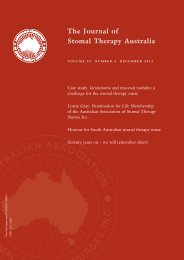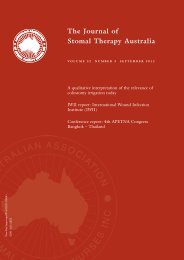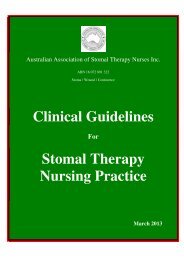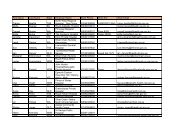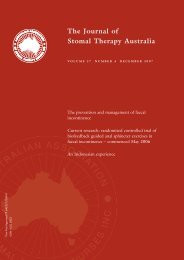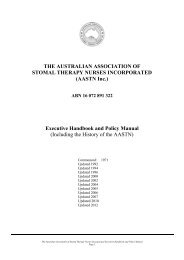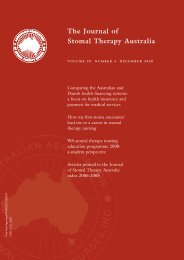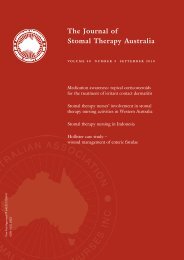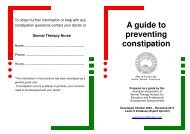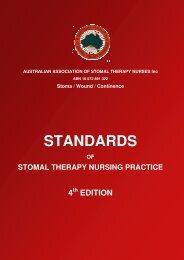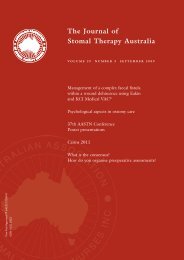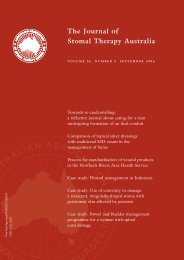JSTA December 2010 - Australian Association of Stomal Therapy ...
JSTA December 2010 - Australian Association of Stomal Therapy ...
JSTA December 2010 - Australian Association of Stomal Therapy ...
Create successful ePaper yourself
Turn your PDF publications into a flip-book with our unique Google optimized e-Paper software.
fragile skin (5.5). After addressing the issue <strong>of</strong> the inappropriate<br />
bandaging, (13.2), my preceptor and I collaborated in the<br />
dressing <strong>of</strong> the wounds (5.1). It was clear that additional support<br />
was required to ensure adequate treatment was provided for<br />
our patient. Her carer was contacted to emphasise her needs<br />
and ensure future appointments were kept, she was provided<br />
with a meal and a taxi was organised to take her home (6.5, 6.6).<br />
The next appointment was kept and our patient was admitted<br />
for intravenous antibiotics after extensive collaboration on the<br />
part <strong>of</strong> my preceptor (5.4). This provided me with an example<br />
<strong>of</strong> advocacy in action. Beyea 11 states that, practising registered<br />
nurses (RNs) have the authority and the responsibility to act in<br />
their patients’ best interest.<br />
My primary mentor also provided me with examples <strong>of</strong> advocacy<br />
during the extensive hours I spent working with her equipping<br />
me with the knowledge to become an advocate myself. Recently<br />
a male patient had undergone an extensive debridement <strong>of</strong> a<br />
necrotic perineal lesion, including debridement <strong>of</strong> part <strong>of</strong> the<br />
anal sphincter. After consultation with the infectious diseases<br />
consultant (ID) and the surgeon (5.1) I attempted to apply a<br />
suction dressing to the area. However, due to the proximity<br />
<strong>of</strong> the wound to the anus, it was impossible to obtain a seal<br />
without covering the anus. The patient was ventilated in<br />
intensive care and neutropaenic as a result <strong>of</strong> treatment for<br />
lymphoma; therefore the friability <strong>of</strong> the rectum prevented the<br />
use <strong>of</strong> rectal tubes to control faecal output. Containment devices<br />
were also inappropriate as they would not stick. This man was<br />
also receiving alimental feeding through a nasojejunal tube.<br />
This was causing diarrhoea so the wound was being constantly<br />
contaminated. After considering many dressing options,<br />
discussion with my mentor and ostomy and wound care<br />
suppliers and reference to The Journal <strong>of</strong> <strong>Stomal</strong> <strong>Therapy</strong> Australia,<br />
World Council <strong>of</strong> Enterostomal Therapists Journal and online<br />
literature search (6.1) I approached the ID consultant regarding<br />
the possibility <strong>of</strong> a temporary stoma to facilitate wound healing.<br />
This took some courage as up till now I have played a minor role,<br />
always deferring to my mentor. I also realised that if I made a<br />
recommendation that was inappropriate, the patient could suffer<br />
(3.2). Vaartio, Leino-Kilpi, Saantera and Suominen 12 believe<br />
that the question <strong>of</strong> appropriateness <strong>of</strong> an action can only be<br />
answered by the patients who are supposed to benefit from it. I<br />
chose the ID consultant with whom to discuss this issue because<br />
he had the best overall knowledge <strong>of</strong> the patient’s condition and<br />
would not be biased towards surgical options (5.3). Meanwhile<br />
I prescribed dressings with a hypertonic saline-impregnated<br />
gauze twice daily and as required after bowel motions (4.7).<br />
This type <strong>of</strong> dressing promotes a cleansing effect on exuding,<br />
malodorous wounds, absorbs exudate and bacteria, promotes<br />
autolysis <strong>of</strong> slough and maintains a moist environment 13 . The<br />
ID consultant initially rejected the stoma idea, stating that he<br />
would be reluctant to recommend this action since the bowel<br />
was not a major factor in the patient’s current condition.<br />
However, as the patient’s general condition improved and it<br />
became evident that he was going to recover, this consultant<br />
and the surgeon agreed. He now has a temporary ileostomy<br />
and a negative pressure dressing, which is rapidly contracting<br />
his wound and maintaining a base <strong>of</strong> clean granulation tissue,<br />
expected outcomes as described by Dyson 14 . As the debridement<br />
surgery involved part <strong>of</strong> the anal sphincter, the next issue will<br />
24 Journal <strong>of</strong> <strong>Stomal</strong> therapy australia – Volume 30 Number 4<br />
be continence (4.1). Intact sphincter function is essential to<br />
maintenance <strong>of</strong> continence 15 . I was concerned that the stoma<br />
might be reversed before investigations <strong>of</strong> sphincter control had<br />
been performed. The consultant involved is a general surgeon.<br />
I discussed this issue with him after careful consideration <strong>of</strong> the<br />
correct approach to use (5.4). He assured me that he is planning<br />
to refer to a colorectal surgeon for investigations.<br />
My involvement in the care <strong>of</strong> this patient has also required<br />
stoma education. His mental status has improved from<br />
unconsciousness to full awareness and participation in his<br />
daily care. He is now independently caring for his stoma,<br />
including the cutting out <strong>of</strong> the hole to accommodate the stoma<br />
because it is a “double-barrel”, oval shape. This single case has<br />
encompassed multiple dimensions <strong>of</strong> stomal therapy practice,<br />
including patient teaching, wound management, stoma care,<br />
continence management and the pr<strong>of</strong>essional responsibilities <strong>of</strong><br />
being a patient advocate and practising within one’s scope <strong>of</strong><br />
competence. Through the support <strong>of</strong> my mentor I have been able<br />
to play an influential role (5.5). “Effective clinical supervision<br />
can help to maintain the practitioner’s balance, and effectively<br />
facilitated reflective practice will stimulate self-awareness and<br />
personal growth, thus transforming the life and practice <strong>of</strong> the<br />
individual ” 16<br />
Treatment <strong>of</strong> a female patient who underwent a pelvic<br />
exenteration has allowed me to follow through multiple levels<br />
<strong>of</strong> care. I was asked to provide her pre-admission education for<br />
ileal conduit and colostomy (1.1, 1.3). Her husband was present<br />
during this education and on the day <strong>of</strong> admission when I<br />
answered their questions and sited her for both stomas. The<br />
surgery was performed on a Saturday. She spent two days in<br />
intensive care. I visited her next with the STN. Her colostomy<br />
was dusky. The surgeon was informed (7.2). Blackley 17 states<br />
that this is appropriate. The stents were visible in the urostomy,<br />
which was pink and had a satisfactory spout (1.5). Due to the loss<br />
<strong>of</strong> vascularity <strong>of</strong> the colostomy, the stoma became sloughy and<br />
the spout was no longer effective, which resulted in leaks when<br />
the colostomy was active. Both the urologist and gynaecologist<br />
were made aware <strong>of</strong> the situation (5.5). Both were reluctant to<br />
consider refashioning due to the complexity <strong>of</strong> the previous<br />
surgery. The problem <strong>of</strong> colostomy management had developed.<br />
The output was liquid so at an appropriate postoperative<br />
recovery stage when bowel function was confirmed, steps were<br />
taken to facilitate thickening <strong>of</strong> the stool (8.1). Benefibre and<br />
Loperamide were introduced. The fluid thickened but there<br />
were still leaks. My mentor and I tried several methods <strong>of</strong><br />
approach, including the use <strong>of</strong> seals, paste and convexity with<br />
a belt (13.1) until we reached a successful outcome. Although<br />
thicker, the output remained liquid. The concern was that after<br />
discharge when a firm stool developed, stenosis <strong>of</strong> the stoma<br />
might result in inability <strong>of</strong> the faeces to be expelled 17 . It was<br />
decided to introduce Codeine Phosphate to further thicken<br />
the faecal output, with the surgeon’s cooperation (6.4), to test<br />
the ability <strong>of</strong> the stoma to pass a thicker motion. I performed a<br />
digital examination <strong>of</strong> the stoma tract to identify any stenosis.<br />
None was identified. Digital dilatation may be helpful for stomal<br />
stenosis 18 . Codeine Phosphate was introduced, and as this can<br />
be used to control mild to moderate pain, the Endone which<br />
the patient had been taking was ceased. Codeine Phosphate



